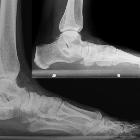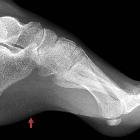pes planus















Pes planus is a deformity of the foot where the longitudinal arch of the foot is abnormally flattened and can be congenital or acquired.
Terminology
Pes planus is also known as flatfoot, planovalgus foot or fallen arches .
Epidemiology
Pes planus may occur in up to 20% of the adult population, although the majority of patients are asymptomatic and require no treatment. Approximately 10% (range 7-15%) of the population with developmental flatfoot go on to develop symptoms requiring medical attention .
Pathology
Pes planus can be :
- congenital: normal in toddlers, may persist into adulthood
- acquired secondary to:
- posterior tibialis tendon degeneration (most common)
- trauma
- neuroarthropathy
- neuromuscular disease
- inflammatory arthritis
In the pediatric population, the degree of ligamentous laxity of the foot results in relative pes planus that resolves over time . Within the first decade, there is spontaneous development of a strong arch in most people .
Pes planus results from loss of the medial longitudinal arch and can be either rigid or flexible. These deformities are usually flexible, which means that on non-weight-bearing views, the alignment of the plantar arch normalizes.
Associations
There are several conditions associated with pes planus :
- tarsal coalition
- certain connective tissue disorders:
There is some evidence to suggest that flat feet protect against stress fractures .
Radiographic features
Plain radiograph
The longitudinal arch of the foot must be assessed on a weight-bearing lateral foot radiograph. If the patient is unable to stand or weight-bear, a simulated weight-bearing radiograph should be obtained.
Weightbearing lateral view
In normal feet, the relationship between the talus and the 1 metatarsal results in a straight line being formed along their axes (i.e. normal Meary's angle = 0°). Pes planus, in contradistinction, will show :
- loss of the normal straight-line relationship with Meary's angle >4° convex downwards
- sagging at the talonavicular or naviculocuneiform joints
- angle of the longitudinal arch increased to >170°
- calcaneal inclination angle <18°
- Disruption of the cyma line: appears as a "lazy S-shape" of the talonavicular and calcaneocuboid joints on both AP and lateral views. It is disrupted owing to anterior shift of the talonavicular joint
Weightbearing dorsoplantar view
It is important to assess:
- hindfoot valgus (where the talocalcaneal angle is >35°)
- talonavicular uncoverage or subluxation
- forefoot abduction
Congenital versus acquired pes planus
Acquired pes planus (i.e., foot collapse), can be distinguished from congenital pes planus by carefully assessing the calcaneus and midtarsal joint:
- in the acquired form, the calcaneal pitch is at least 10°; in congenital pes planus it is less
- in the acquired form, the calcaneus is downwards-concave; in the congenital form it is downwards-convex or flat
- in the acquired form, the midtarsal joint is altered by a forward-jutting talus; in the congenital form the talus is medially displaced, but the midtalar line appears normal (i.e., it is pseudonormal)
Treatment and prognosis
Treatment depends on whether:
- there are symptoms
- pes planus is fixed or mobile
- there are associated findings, e.g. hindfoot valgus
- any associated pathology
Non-operative management for the fixed flat foot is unlikely to be beneficial since there is a fixed relationship between osseous structures.
Siehe auch:
- talonavicular coverage angle
- Ehlers-Danlos syndrome
- pes cavus
- Marfan-Syndrom
- Tarsale Koalition
- Hintermann-Osteotomie
- Talometatarsale-I-Winkel
und weiter:

 Assoziationen und Differentialdiagnosen zu Plattfuß:
Assoziationen und Differentialdiagnosen zu Plattfuß:




